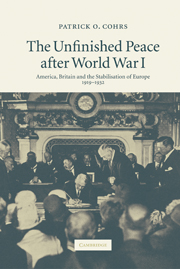Book contents
- Frontmatter
- Contents
- Acknowledgements
- List of abbreviations
- A note on the footnotes and bibliography
- Introduction
- Prologue
- 1 The wider challenges
- 2 Wilson, Lloyd George and the quest for a ‘peace to end all wars’
- 3 The ill-founded peace of 1919
- 4 The escalation of Europe's post-Versailles crisis, 1920–1923
- Part I The Anglo-American stabilisation of Europe, 1923–1924
- 5 Towards a Progressive transformation of European politics
- 6 Towards transatlantic co-operation and a new European order
- 7 The turning-point
- 8 From antagonism to accommodation
- 9 The two paths to the London conference
- 10 The first ‘real’ peace settlement after World War I
- Part II Europe's nascent Pax Anglo-Americana, 1924–1925
- Part III The unfinished transatlantic peace order: the system of London and Locarno, 1926–1929
- Epilogue
- Conclusion
- Map: Post-World War I Europe after the peace settlement of Versailles
- Bibliography
- Index
10 - The first ‘real’ peace settlement after World War I
The London agreement of 1924 and the consequences of the ‘economic peace’
Published online by Cambridge University Press: 21 July 2009
- Frontmatter
- Contents
- Acknowledgements
- List of abbreviations
- A note on the footnotes and bibliography
- Introduction
- Prologue
- 1 The wider challenges
- 2 Wilson, Lloyd George and the quest for a ‘peace to end all wars’
- 3 The ill-founded peace of 1919
- 4 The escalation of Europe's post-Versailles crisis, 1920–1923
- Part I The Anglo-American stabilisation of Europe, 1923–1924
- 5 Towards a Progressive transformation of European politics
- 6 Towards transatlantic co-operation and a new European order
- 7 The turning-point
- 8 From antagonism to accommodation
- 9 The two paths to the London conference
- 10 The first ‘real’ peace settlement after World War I
- Part II Europe's nascent Pax Anglo-Americana, 1924–1925
- Part III The unfinished transatlantic peace order: the system of London and Locarno, 1926–1929
- Epilogue
- Conclusion
- Map: Post-World War I Europe after the peace settlement of Versailles
- Bibliography
- Index
Summary
The outcome of the London conference was already widely perceived in the summer of 1924 as a veritable caesura both in European and transatlantic relations. Yet the question as to precisely what kind of caesura it constituted has remained decidedly controversial. Previous accounts have uncovered countless nuances, conflicts and reversals marking the intense negotiations between the ‘anodyne’ opening speeches of 16 July and invocations of a new international spirit on 16 August 1924. Yet they have also drawn a markedly polarised picture of what shifts in the post-Versailles constellation the conference brought about.
Most influentially, London has been interpreted as the first high-point of short-sighted Anglo-American appeasement after 1919 that, with the pursuit of narrow financial interests, eroded the Versailles system. Anglo-American policymakers and financiers allegedly forced a settlement on France that undermined not only French but all western possibilities to prevent a perilous resurgence of Germany. Accordingly, the agreement has been termed an unquestionable ‘victory’ for German revisionist policy – the stepping-stone for its attempts to alter not only the reparations clauses but also the wider status quo of Versailles. Yet the London conference has also been called critical for a continued ‘republican’ policy of peaceful revision under Stresemann. Can the outcome of London thus essentially be gauged in terms of Europe's balance of power – where Germany's position clearly improved? Or did it have a different, positive impact on Europe's stabilisation in the 1920s?
- Type
- Chapter
- Information
- The Unfinished Peace after World War IAmerica, Britain and the Stabilisation of Europe, 1919–1932, pp. 154 - 184Publisher: Cambridge University PressPrint publication year: 2006



